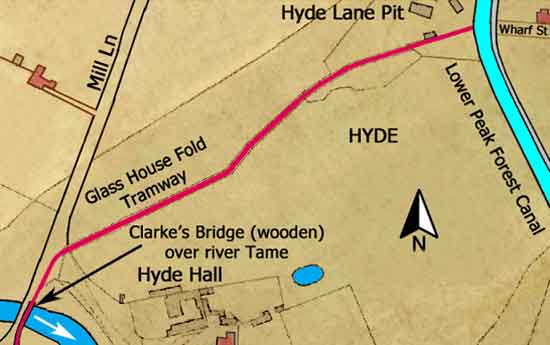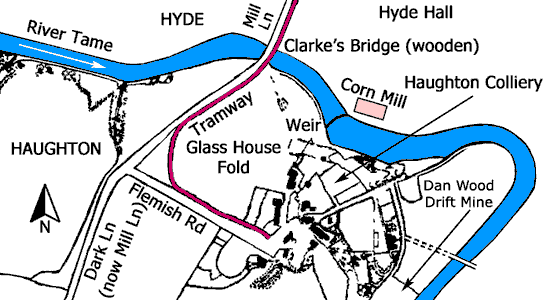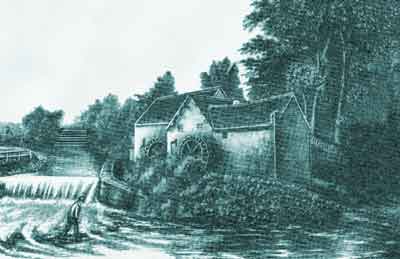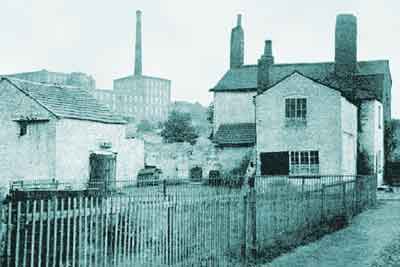
Sometime in the 16th century a group of Protestant Flemish refugees settled in the part of Haughton Green that became known as Glass House Fold. The Hyde Clarke family owned the land upon which they settled and their family seat was just across the river Tame in Hyde. These refugees were skilled glassmakers and they quickly founded a local glass-making industry. In order to make glass furnaces were built which were fired using the ample supplies of coal that lay just below the ground. Accordingly, pit shafts were sunk within the confines of the hamlet (Haughton Colliery) and a drift mine (Dan Wood Drift Mine) was driven into the valley side a short distance to the south. References to glassmakers can be found in the registers at Stockport Parish Church between 1605 and 1644, after which there is no further mention. In 1696 a list of English glass houses was published and this makes no mention of the hamlet. Hence, it is likely that glass making ceased there between 1644 and 1696. Nevertheless, coal could still be mined and throughout the 18th century and into the early years of the 19th century the hamlet was a busy mining centre.
Records of the surnames of glassmakers found in the registers of Stockport Parish Church (St Mary’s in the Marketplace) include: Beacher, Clerke, De Hooke, De Howe, Hartley, Harvey, Pylmey and Shegh. It is likely that some of these families initially extracted coal from natural outcrops that occurred in the side of the Tame Valley to fire glass-making furnaces that were in use between 1605 and 1644. One such coal outcrop that was worked was the Dan Wood Drift Mine.
Work on cutting the Peak Forest Canal commenced in 1794 and George Hyde Clarke became a major shareholder in the canal company. He was mindful that coal from Glass House Fold could also be exported along the canal as well as into Hyde. To facilitate this, a tramway was constructed between Glass House Fold and the Peak Forest Canal in Hyde. As constructed, this tramway ran along the north side of the access lane to Glass House Fold (now Flemish Rd) before turning northwards to run along the south side of Dark Ln (now Mill Ln) where it crossed the river Tame on a wooden bridge. It then continued for a short distance alongside Mill Ln before it veered in a north-easterly direction to climb the valley side towards the Peak Forest Canal. It arrived at the Peak Forest Canal in the vicinity of Hyde Ln Pit, which adjoined Hyde Change Bridge over the canal. Here there was a coal staithe where boats could be loaded with coal. The date of closure of the tramway is uncertain but it is likely that it was around the 1830s.
Messrs Brown and Clayton were appointed as the lessees of the coal mines at Glass House Fold. These were the business partners Thomas Brown and William Clayton and Thomas Brown was also the Surveyor and Resident Engineer for the Proprietors of the Peak Forest Canal Company.

Glass House Fold Tramway, Hyde, 1841.

Glass House Fold Tramway Haughton Green, 1848.

Engraving of Hyde Corn Mill.
A water-powered corn mill is said to have stood on this site since the reign of John (King of England 1199-1216) and it was demolished in 1885.
This view shows a weir and stepping stones across the river Tame. The wooden bridge, known as Clarke’s Bridge, is just visible on the edge of the view on the left. This connected Mill Ln, Hyde, to Dark Ln, Haughton Green, which is off the picture to the left. It also carried the Glass House Fold Tramway over the river. It was demolished in 1885.

Glass House Fold, c.1910.
There are no records or archaeological evidence to shed light on the type of tramway in use at Glass House Fold. It is likely that it resembled the underground tramway systems used in Haughton Colliery and Dan Wood Drift Mine. Thus, the gauge of the track would have been around 19 or 20 inches, similar to other mine tramways in the neighbourhood, especially those in the Cheshire coal field. If this supposition is correct, then coal tubs would have been of wooden construction with cast-iron wheels having a capacity of about 5 cwt. These would have been hauled by ponies on the relatively level parts of the tramway but rope/chain haulage was most likely used over the steep hillside up to the canal. Consequently, it is possible that an incline was constructed over the hillside with a horse gin at the top to draw up loaded coal tubs to the canal bank. Whether the rails used were I-section or L-section is unknown, neither is it known whether these were secured to wooden sleepers or stone sleeper blocks.